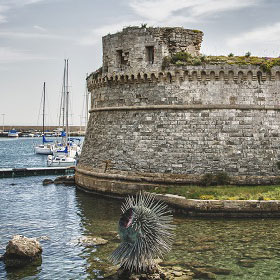Phone : +41 79 956 85 16
GALLIPOLI
x
Gallipoli is considered one of the jewels of Salento. It is divided into two areas: Borgo and Centro storico (old town). The Centro storico is located on an island of limestone origin and is completely surrounded by the sea. It is connected to the mainland by a bridge. The Borgo is the recent part of Gallipoli with modern buildings, such as the Palazzo di vetro which looks like a skyscraper.
The old town is rich in beautiful historical buildings and magnificent churches. Its narrow streets look like a labyrinth and invite you to discover shops, bars, small grocery stores, etc.

St. Agatha's Cathedral and Baroque churches
The majestic cathedral seems to be hidden between the narrow streets. But you only have to raise your eyes to admire the beauty of Lecce's Baroque style. It was built in the middle of the 17th century and houses large paintings by the artist Coppola, originally from Gallipoli.
You will be charmed by the beauty and style of these churches.
Greek fountain
The Greek fountain is located near the bridge that connects the Borgo to the Centro storico.
The facade is divided into three parts by four caryatids that support the lintel with a rich decoration and is about 5 m high. In the bas-reliefs, made of local hard stone slabs, are carved scenes representing the three metamorphoses of the mythological Dirce, Salmace and Biblide.

Il frantoio del Vicerè
(Vicerè oil mill)
The Vicerè oil mill is one of thirty-five oil mills located in the basement of the old town with about two thousand tanks used to store the oil. From the mid-1500s to the late 1800s, oil was considered a very precious material, a real treasure comparable to petroleum and gold. Entering this small oil mill is like taking a step back in time. Inside, a guide tells visitors the story of its construction, explains how the oil was produced, recalls the conditions under which workers bent for months, bringing home at the end of the season a precious wage that would allow them to feed their families for many years.
CONTACT US
- BOOK NOW -
© Copyright 2021 palazzettobuccarelli.com
developed by swiss-envy.ch


